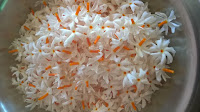Durga puja brings together the joy and happiness in every Indians' life. Durga puja also brings new beauty to the mother nature. The night jasmine flowers blossom during this season and brings a purity to the atmosphere. Night jasmine flowers bloom at night and fall down in the morning.
Night jasmine or Coral jasmine is called Shewali phul in Assamese. These flowers are widely used in Assamese Cuisine and yes these flowers are edible. Its new leaves are coated in a batter and deep fried in oil. Bor / pokoras can also be made from these flowers. A Khar recipe also can be made. My mother used to make a khar recipe using broken rice and night jasmine flowers, which was very tasty. Dry flowers are used to make fish curry. Below I have shared three different recipes of night jasmine flowers.
The recipe of Stir fried night jasmine flowers with potato :
Ingredients:
- 1 big potato
- 1 bowl of night jasmine flowers
- 1 small onion finely chopped
- 1/3 tbsp turmeric powder
- 2 green chillies finely chopped
- 2 tbsp oil
- Salt to taste
- Peel potatoto and make small pieces.
- In a pan heat oil. Add chopped onions. Fry until golden brown. Add turmeric powder. Add choppped green chillies and potato pieces. Add salt. Stir and fry until potatoes cooked.
- Just before removing from heat add night jasmine flowers. Mix well with potatoes. Remove from heat. Server hot with rice as a side dish.
The recipe of Fish curry with dry night jasmine flowers
Dry night jasmine flowers
Ingredients:
- 100 gms of tiny small fishes
- 1/2 cup dry night jasmine flowers
- 5-6 garlic cloves finely chppped
- 2-3 green chillies chopped
- 1 tbsp khar (optional)
- 2-3 tbsp oil
- Salt to taste
Method:
- Clean and wash fishes. Rub with salt and turmeric. In a pan heat oil. Fry fishes and drain and keep aside .
- In the remaining oil add chopped garlic cloves. Fry until colour changes. Add green chillies and dry night jasmine flowers. Add salt and 1 cup of water. Bring to boil.
- Add fried fishes.
- Add khar.
- Cook for 5 minutes. Remove from heat.
- Serve with rice.
Shewali phulor khar:
Ingredients:
- 1/2 cup sun dried night jasmine flowers
- 2 tbsp cooked rice
- 1 tbsp khar ( kolkhar/ banana khar)
- 1/2 tbsp mustard oil
- 2 cups of water
- Salt to taste
- In a pan boil 2 cups of water. Add sun dried night jasmine flowers and cooked rice. Bring to boil. Add 1 tbsp khar and cook till water reduced 1/3rd.
- Remove from heat. Add raw 1/2 tbsp mustard oil.
- Serve as a starter with boiled rice.
* My father used to make another khar recipe from dry night jasmine flowers with fish head which I'll share some other day.





Sounds tasty, I did not have the chance to. Try it
ReplyDeleteAwesome recipe, great result Thanks for sharing it!
ReplyDelete